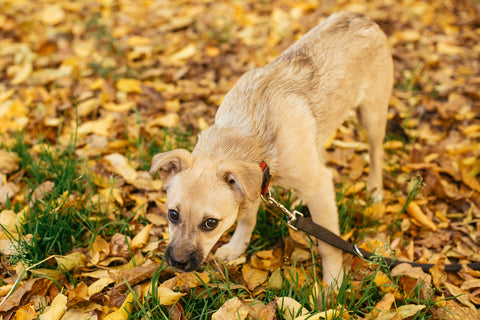Why Are Dogs Scared of Thunder? Exploring Dog Storm Anxiety
It's a dark and stormy night, and you find yourself comforting your trembling and anxious furry friend as a thunderstorm rolls in. Many dog owners can relate to the sight of their beloved pets cowering, panting, or seeking refuge during a thunderstorm. But have you ever wondered why dogs are scared of thunder?
In this blog article, we'll explore the reasons behind canine storm anxiety and how you can help your four-legged companion during these stressful times.
Thunderstorms and Your Dog: What You Need to Know

The Science Behind Dogs' Fear of Thunder
Sensory Sensitivity
Dogs have incredibly acute senses, which can be a blessing and a curse. When it comes to thunderstorms, the loud claps of thunder, sudden flashes of lightning, and the accompanying changes in barometric pressure can be overwhelming for dogs. Their sensitive hearing allows them to hear sounds at frequencies that humans cannot, making the thunder even more startling. Additionally, the static electricity generated by lightning can sometimes cause discomfort or pain for some dogs.
Evolutionary Ancestry
To understand your dog's fear of thunder, it's essential to consider their evolutionary history. Ancestors of modern dogs were wild animals, and many of them would seek shelter during thunderstorms to avoid being exposed to the elements or potential dangers. This natural survival instinct may be a contributing factor to your dog's unease during storms, as they instinctively try to find safety and comfort.
Associative Trauma
One reason your dog might be scared of thunder is previous negative experiences during storms. Dogs can be highly associative animals, and if they've experienced a traumatic event during a storm, such as being stuck outside during a downpour or a close lightning strike, they may associate the sounds and sensations with fear and anxiety in the future.
Lack of Control
Dogs, like humans, can experience anxiety when they feel a lack of control over their environment. Thunderstorms are unpredictable and uncontrollable, which can exacerbate your dog's anxiety. The inability to understand or predict when a storm will end or whether they are safe can lead to distress.
Social Cues
Dogs are incredibly attuned to their human companions, and they often pick up on your emotions and reactions. If you react with concern or fear during a storm, your dog may mirror your emotions and become even more anxious. It's crucial to remain calm and reassuring during thunderstorms to help alleviate their anxiety.
How to Tell if Your Dog is Scared of Thunder?
Recognizing signs of thunderstorm anxiety in your dog is crucial for providing the right support and comfort during stormy weather.
Here are some common indicators that your dog may be scared of thunder:
Trembling and Shaking: One of the most apparent signs of fear is when your dog starts trembling or shaking uncontrollably. This physical reaction is a clear sign of anxiety.
Panting and Drooling: An anxious dog may exhibit heavy panting and excessive drooling during a thunderstorm. This behavior is often a response to stress.
Pacing and Restlessness: If your dog is constantly moving around the house, unable to settle, it may be due to their discomfort and fear of the storm.
Seeking Shelter: Dogs often look for a safe place to hide during a thunderstorm. This might be under furniture, in a closet, or even a bathtub.
Whining or Barking: Vocalization is another way dogs express their anxiety. Your dog may whine, whimper, or bark more than usual during a storm.
Clinginess: Dogs that are scared of thunder may become overly clingy, seeking physical contact and comfort from their owners.
Destructive Behavior: Anxiety can sometimes lead to destructive behavior, such as scratching doors, chewing furniture, or attempting to escape.
Excessive Licking or Chewing: Dogs may lick or chew their paws or other body parts when anxious, which can lead to skin irritations.
Loss of Appetite: Some dogs lose their appetite during thunderstorms due to stress. They may refuse to eat or drink.
Dilated Pupils and Wide-Eyed Look: Fear can cause a dog's pupils to dilate, giving them a wide-eyed, intense expression.
Hiding or Digging: Your dog might dig at the ground or hide in unusual places, like the corner of a room, when they're frightened.
Involuntary Elimination: Extremely fearful dogs may urinate or defecate indoors, even if they are typically well-trained.
Excessive Salivation: Some dogs may drool excessively when anxious, leaving noticeable wet patches.
Aggression: In rare cases, a scared dog may become aggressive due to heightened fear. It's crucial to handle such situations with caution.
Keep in mind that not all dogs will display every one of these signs, and individual reactions can vary. If you notice any of these behaviors during thunderstorms, it's important to offer comfort and support to help your dog feel safe and secure.

How to Help Your Dog During Thunderstorms
Now that we understand some of the reasons behind canine storm anxiety, let's explore how you can help your dog during thunderstorms:
Create a Safe Space: Provide a safe and comfortable space for your dog to retreat to during a storm. This could be a crate, a designated room, or a cozy corner with their favorite toys and blankets.
Desensitization and Counterconditioning: You can work with a professional dog trainer to desensitize and countercondition your dog to the sounds of thunder over time, gradually reducing their fear.
White Noise: Use white noise machines or calming music to drown out the thunder sounds and create a soothing environment.
Anxiety-Reducing Aids: Consider using anxiety-reducing aids like Thundershirts, anxiety wraps, or calming pheromone diffusers to help your dog feel more secure.
Distraction Techniques: Engage your dog in activities they enjoy, such as playing with their favorite toys or practicing obedience commands. Redirecting their attention can help them focus on something other than the storm.
Behavior Modification Training: Consult with a professional dog trainer or behaviorist who specializes in treating anxiety. They can create a customized behavior modification plan to help your dog overcome their fear of thunder.
Gradual Exposure: Consider using audio recordings of thunderstorm sounds at a very low volume and gradually increasing the volume over time. This controlled exposure can help desensitize your dog to the noises associated with storms.
Thunderstorm Apps: Some smartphone apps are designed to mimic the sounds of thunderstorms. These apps can be useful for desensitization training under controlled conditions. Remember to pair this with positive reinforcement, like treats and praise.
Medication as a Last Resort: In severe cases, where your dog's anxiety significantly impairs their quality of life, medication prescribed by a veterinarian may be necessary. Medication can be used temporarily during thunderstorms or as a longer-term solution, but it should always be administered under professional guidance.
Calming Supplements: Some dogs benefit from natural calming supplements, such as chamomile, valerian root, or CBD products. Always consult with your veterinarian before introducing any supplements to your dog's routine.
Consistency and Routine: Dogs find comfort in routine. Try to maintain a consistent daily schedule and reassure your dog during storms with soothing words and gentle petting.
Safe Identification: Ensure that your dog has proper identification, such as a collar with an ID tag and a microchip. Storms can sometimes cause dogs to panic and escape, so it's essential to be prepared in case they get lost.
Every dog is unique, so it may take some trial and error to find the best combination of strategies that work for your furry friend. Remember that your love, support, and understanding are crucial elements in helping your dog feel safe and secure during thunderstorms.
